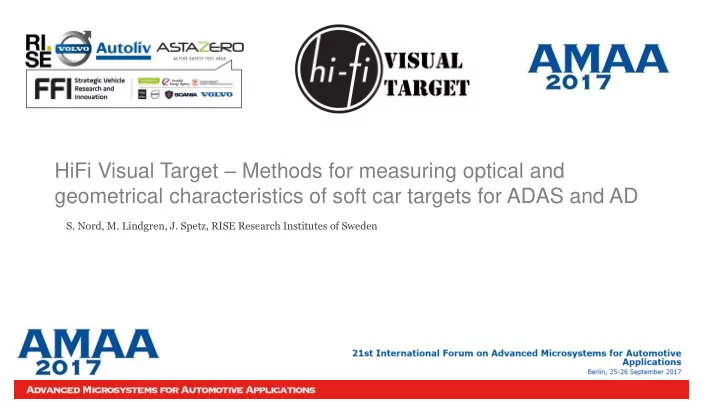

HiFi Visual Target – Methods for measuring optical and geometrical characteristics of soft car targets for ADAS and AD S. Nord, M. Lindgren, J. Spetz, RISE Research Institutes of Sweden
Project Information Project name: HiFi Visual Target Budget: 510 k € Funding: Vinnova FFI Project duration: 2016-10-01 – 2018-03-31 Project coordinator: Stefan Nord stefan.nord@ri.se Partners: RISE, Volvo Cars, Autoliv, AstaZero 2
Background Different types of optical sensors are important for Advanced Driver Assistance Systems (ADAS) and Autonomous Driving (AD) vehicles due to their ability to detect different objects at different distances and angles. To ensure reliability of optical sensors, extensive testing with 3D soft car targets is needed. Due to non-perfect shape and materials, the optical characteristics of 3D soft car targets may differ considerably from that of real vehicles, resulting in different detection performance, and unreliable activation of the functions. During tests the quality of the 3D soft car targets deteriorates, which means that there is also a need of methods for securing the quality of the 3D soft car target over time. Productivity on the proving ground is important!!! 3
Background Typical sensors for ADAS och AD vehicle sensing systems: This project focus on optical sensors 4
Background Example of a 3D soft car target and a target carrier for testing of active safety systems: 5
Project Objectives The objective of the project is to enable more efficient and reliable verification of optical sensor systems, including ADAS and AD systems that rely on the optical sensors, through: Development and validation of accurate and repeatable measurement methods of the optical and geometrical characteristics of 3D soft car targets. Provide input to the development of more realistic 3D soft car targets for safe testing of automotive optical sensor systems. Demonstration of improved verification with the developed measurement methods. Supporting international standardisation (ISO) with standard methods enabling future verification and calibration of optical characteristics of active safety 3D soft car targets. ISO/TC 22/SC 33/WG 16 ISO 19206 part 3 (3D vehicle target) 6
Measurements of optical and geometrical properties Measurements done with: Spectroradiometer Stereo-camera from Autoliv 3D-geometry-scanning Laser scanner Two targets selected, one new and one heavily used Soft car target “mint condition” as used in measurements. Soft car target “ heavily used” as used in measurements. 7
Measurements of optical and geometrical properties Measurement done in controlled environment indoors 8
Measurements of optical and geometrical properties Example of the image collected by the vehicle camera system. Four black pointers on the SCT side indicate the position of measurement spots for the spectroradiometer. Also visible on the floor are the markings for center position and rotation of the 3D soft car target. Results from the 3D-scanning: 9
Preliminary Results Analysis of measurement data is ongoing Measurements have now also been done on a set of real cars in a similar way, and the results will be compared with measurements on the 3D soft car target. 10
Preliminary Results – Spectral Reflectance Raw data for spectral reflectance. Further analysis is required to determine the relevant differences between the new and used SCT in order to develop valid quality criteria's. 1,0 1,0 Used SCT New SCT 0,9 0,9 0,8 0,8 Relative spectral reflectance 0,7 Relative spectral reflectance 0,7 0,6 0,6 0,5 0,5 0,4 0,4 0,3 0,3 0,2 0,2 0,1 0,1 0,0 0,0 400 500 600 700 800 900 1000 1100 400 500 600 700 800 900 1000 1100 Wavelength (nm) Wavelength (nm) 11
Preliminary Results – 3D geometry scan Left column shows result for the new SCT, right column for the heavily used SCT. 12
Conclusions and Future Work 3D soft car targets are standardized and used for EuroNCAP Need of standardized methods to validate and secure the quality of targets both from a production perspective and from a lifetime and usage perspective. Work during autumn 2017: Continuation of analysis of captured data. Measurements on new 3D soft car targets from DRi (version 2018) and from 4a technologies. Accelerated ageing tests will be done on a 3D soft car target: Hitting the target ~300 times while measuring reflectance, geometry and also collecting data with a real ADAS system (camera system from Autoliv) Investigating if there is a (mobile) method that could be used for validating the 3D car target in order to decide if it has to be repaired/replaced or not. 13
THANK YOU! Stefan Nord stefan.nord@ri.se +46-(0)10-5165931 Research Institutes of Sweden Safety and Transport Measurement Science and Technology www.ri.se
Recommend
More recommend